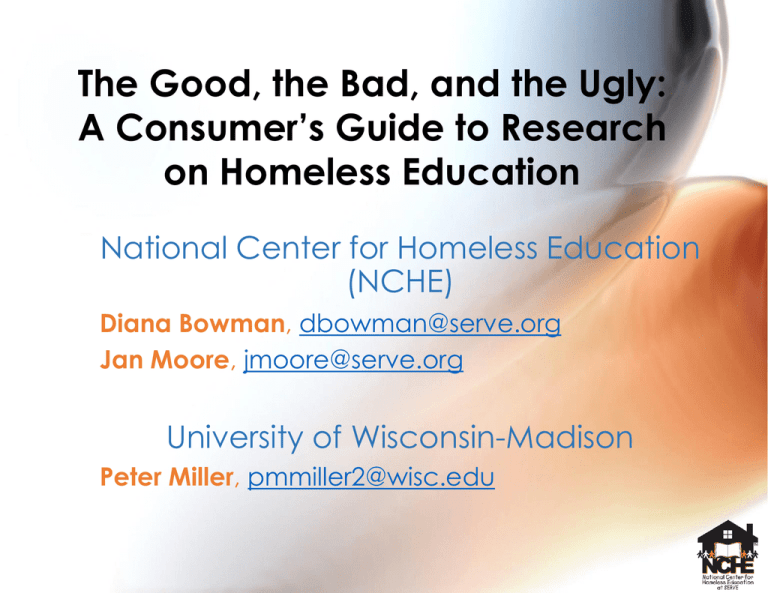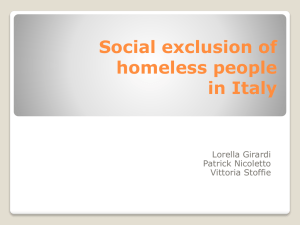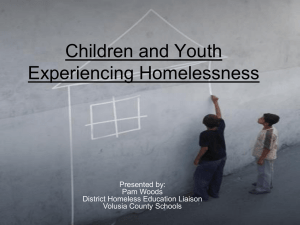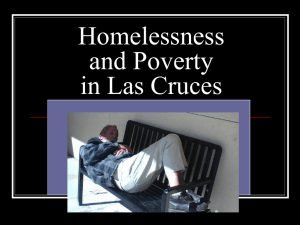A Consumer`s Guide to Research on Homeless Education
advertisement

The Good, the Bad, and the Ugly: A Consumer’s Guide to Research on Homeless Education National Center for Homeless Education (NCHE) Diana Bowman, dbowman@serve.org Jan Moore, jmoore@serve.org University of Wisconsin-Madison Peter Miller, pmmiller2@wisc.edu NCHE Research Publication • Summary of the State of Research on the Relationship Between Homelessness and Academic Achievement Among SchoolAged Children and Youth • http://center.serve.org/nche/pr/research_pub.php • Released in January 2012 • Overview of research on the relationship between homelessness and academic achievement among school-aged children and youth in the US NCHE Research Publication • More specifically… Reviews child, youth, and family homelessness from 1980s to present Summarizes policies and practices that link homeless students to educational supports Provides overview of research on homeless students and academic achievement Describes common research methods and challenges related to homeless and highly mobile populations Offers direction for further research Today’s Session • Overview of research • History of research on homeless families and children • Challenges in conducting research on homeless children, youth, and families • Potential for more good quality studies • Goals of and directions for future research • Tips for becoming wise consumers of research What information is available to inform our work? • Opinions • Descriptions of and anecdotes about good practices • Personal stories about working with children, youth, and families • Research studies Conduct objective investigation Examine data to support, refute, or explain something Show circumstances of what’s been tried and results of the implementation Research Characteristics • Empirical – based on collection of “data” • Systematic – involves specific steps (identifying problem, reviewing literature, collecting data, analyzing data, and drawing conclusions) Research Characteristics (cont.) • Valid – measures what it is intended to measure Comparable term”trustworthiness” • Reliable – extent to which results can be repeated Comparable term”credibility” Research Terms • Independent variable – what is changed by the researcher (e.g., types of tutoring programs) • Dependent variable – what is measured (e.g., student achievement) • Quantitative research – collects data in the form of numbers (e.g., test scores) • Qualitative research – collects data in the form of words by methods such as observations and interviews Types of Research Studies • Experimental – designed to identify cause-effect relationships between an independent variable and a dependent variable • Descriptive - describes data and characteristics about the population or phenomenon being studied. Does not answer questions about how/when/why the characteristics occurred Types of Research Studies (cont.) • Causal Comparative – uses two categorical groups (e.g., homeless and housed) to compare performance on a specific condition • Correlational – only looks for relationship among variables (e.g. math ability and reading ability); no variables are categorical Even when a relationship between variables is identified, we must first determine if extraneous variables were adequately controlled before concluding there is a cause and effect relationship History of Child, Youth, and Family Homelessness – Beginning in 1980s • Increasing numbers of families with children • Pressure for government response Federally funded housing supports Began to address educational barriers for homeless students: Stewart B. McKinney Homeless Assistance Act (later renamed McKinney-Vento Homeless Assistance Act) Two Waves of Research on Homeless Families and Children • • First wave: mid-1980s thru1991 Documented scope and dimension of crisis Found higher retention, absenteeism, behavior and emotional problems; lower test scores Second wave: began 1992 Risk continuum: most to least risk 1.) homeless, 2.) housed but living in poverty, 3.) general population Co-occurring risk factors Diverse subgroups of homeless students with unique traits and needs Mediating factors affecting homeless students’ school success Research Challenges • Difficulty obtaining significant and representative samples Most research done in large urban area shelters; does not represent other homeless living arrangements or geographic areas High mobility makes it difficult to maintain a statistically significant sample size; participants move, reducing the sample size and creating a selection bias of lessmobile students Lack of longitudinal studies Few studies consider academic performance prior to or after experiencing homelessness Research Challenges (cont.) • Findings not generalizable beyond location, time, and population studied Very context-specific, potentially reflecting: Particular location of the study Economic trends at the time Local demographics Availability of resources and support for homeless families and children Local policies and practices National policies related to homelessness at the time Research Challenges (cont.) • Viewed homeless children, youth, and families as homogeneous population No consideration of subgroup differences such as Causes, frequency, and duration of homelessness Mental and physical health Personal experiences Academic achievement Quality of parenting Research Challenges (cont.) • Lack of consensus on whether homelessness is a condition or marker. Is homelessness a: discrete condition that impacts children and youth’s academic achievement? OR a marker for a constellation of conditions (poverty, lack of stable housing, mobility, etc.)? Studies may not have adequately measured and/or controlled for the effects of additional risk factors Research Challenges (cont.) • The most practical study methods may not yield quality data Research setting affects data Shelter noise and chaos may impact performance on research instruments Self-reported information is usually less reliable than information provided by normed tests Surveys and interviews (self-reported information) are often used with homeless families Potential for More Good Quality Studies • Increased visibility and awareness Family homelessness is more visible due to economic and foreclosure crisis Led to heightened awareness of and interest in homeless issues among the general public, federal agencies, and foundations Potential for More Good Quality Studies (cont.) • Improvement in data quality SEA and LEA data systems and proficiency in data analysis are improving ED’s CSPR data requirements enable researchers to study larger samples encompassing multiple districts, states, and types of primary nighttime residences Use of unique student identifiers is becoming more widespread, enabling researchers to conduct longitudinal studies Potential for More Good Quality Studies (cont.) • Increased collaboration on data collection Federal agencies (HUD, HHS, ED, etc.) are working to improve collaboration in data collection and sharing Youth Point-in-Time Count Beginning in January 2013, CoCs are required to include the number of youth (18-24) seen during their counts Potential for More Good Quality Studies (cont.) • More targeted research questions Limitations of previous research show need to: Recognize diversity among homeless families, children, and youth Explore differences among subgroups • Why do some homeless children succeed despite challenges and barriers while others do not? Focus research on strengths, not weaknesses • Why do some students excel academically? • What interventions create resilience in students despite challenges? Goals of and Directions for Future Research • Determine factors correlated with educational success Examine homelessness in the context of other adversities impacting homeless students Identify contextual and moderating influences that have produced inconsistent study results Focus on what facilitates resilience Past studies focused on deprivation, but many students succeed despite challenges Conduct large multi-site study Would provide more comprehensive understanding of these factors Goals and Directions for Future Research (cont.) • Improve educational practices and interventions Make more systematic efforts to gather, examine, and apply evidence related to the effects of policies and programs Conduct national conversation among researchers, educators, and policy makers to better understand homeless students and ways to increase their success in school Wise Consumers of Research: Good Questions to Consider • How old is the study? If prior to M-V reauthorization, is it still relevant? • Is there a clearly stated hypothesis or research question logically based on the literature review? • Does the background information/literature review refer to credible and relevant sources? • Is a research design stated? Is the methodology described? Are subjects representative? Are the comparison groups appropriate? • Do authors discuss correlational/causation limitations or cautions in their conclusions? • Are claims appropriate for the type of study?








